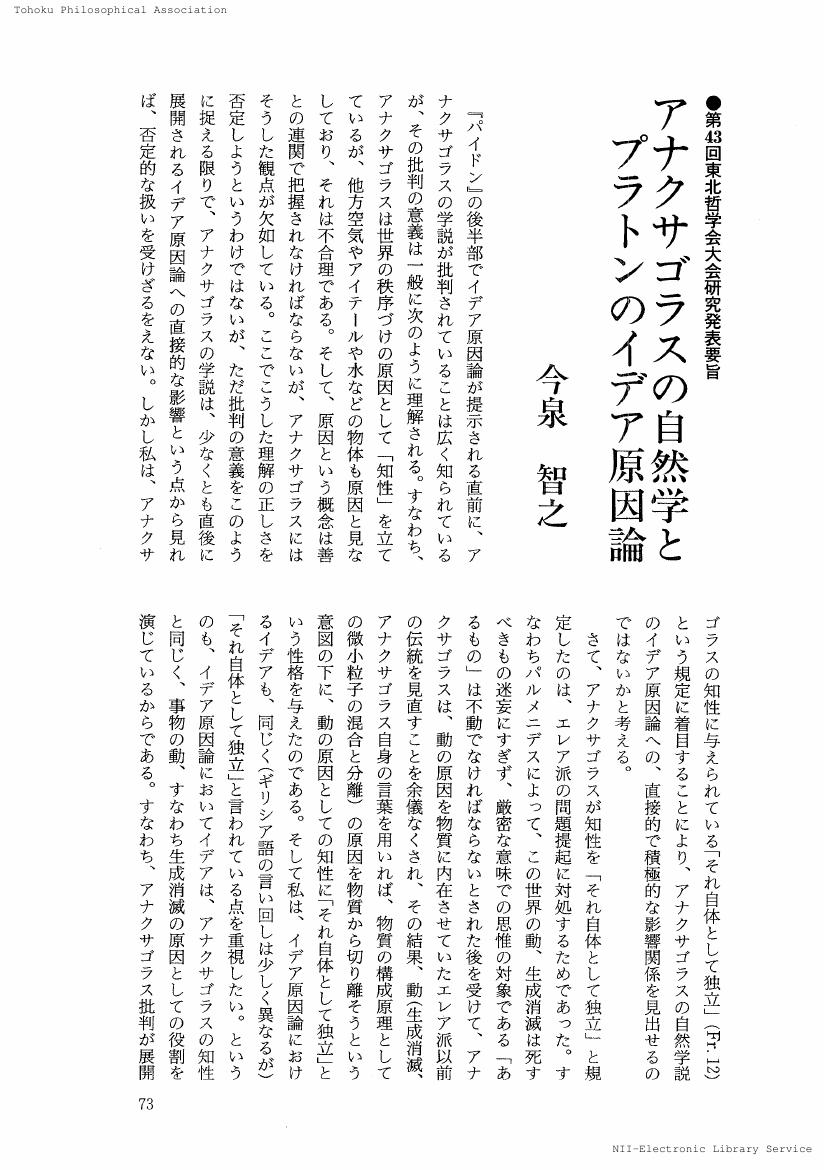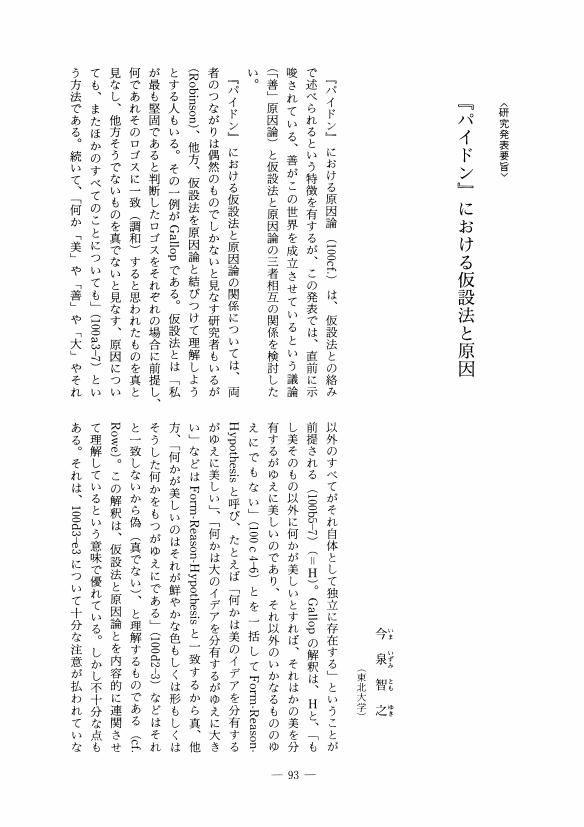1 0 0 0 OA 『テアイテトス』(184b-186e)について(第53回大会研究発表要旨)
- 著者
- 今泉 智之
- 出版者
- 東北哲学会
- 雑誌
- 東北哲学会年報 (ISSN:09139354)
- 巻号頁・発行日
- vol.20, pp.73-74, 2004-05-31 (Released:2018-02-28)
1 0 0 0 OA アナクサゴラスの自然学とプラトンのイデア原因論
- 著者
- 今泉 智之
- 出版者
- 東北哲学会
- 雑誌
- 東北哲学会年報 (ISSN:09139354)
- 巻号頁・発行日
- vol.10, pp.73-74, 1994-06-30 (Released:2018-02-28)
1 0 0 0 アナクサゴラスの自然学とプラトンのイデア原因論
- 著者
- 今泉 智之
- 出版者
- 東北哲学会
- 雑誌
- 東北哲学会年報 (ISSN:09139354)
- 巻号頁・発行日
- vol.10, pp.73-74, 1994
1 0 0 0 『パイドン』における「もつ」,「分有する」と述語づけ
- 著者
- 今泉 智之
- 出版者
- 日本西洋古典学会
- 雑誌
- 西洋古典学研究 (ISSN:04479114)
- 巻号頁・発行日
- vol.44, pp.37-47, 1996
<p>How are the following three propositions related to each other in the Phaedo? A Something is beautiful. B Something has(echei)beauty(immanent form or character). C Something participates in (metechei) beauty (transcendental Form). Some scholars(e. g. Vlastos, Fujisawa)identify A with B and consider C is the cause(reason) (aitia)of both A and B, but in my view this interpretation is open to further discussion. Plato does not identify A with B, but rather thinks B may also be the cause of A. This paper further considers this point. If anything else is beautiful besides beauty itself, it is so only because (dioti) it participates in that beauty(100c4-6). This sentence suggests that C is merely the cause(dioti)of A, and in the following passages of the Phaedo it is never said that B is caused by C. Simmias overtops Socrates because (hoti) Socrates has smallness in relation to Simmias' largeness(102c2-5). "Simmias overtops Socrates" is similar to "Socrates is smaller than Simmias" and "smallness" is immanent form. If so, the import of this sentence is that B is also entitled to be the cause(hoti)of C. In this respect, the next sentence is important. Nothing else makes a thing beautiful except beauty itself, whether by its presence or communion or whatever the manner and nature of the relation may be(100d4-6). The meaning of the word "presence(parousia)" is close to "echein" and "communion(koinonia)" to "'metechein". Of course the immanent form (beauty)does not appear clearly in this sentence, but the ambigious expression "whatever the manner and nature of the relation may be" alludes to it. If this understanding is correct, the role of this sentence is to suggest that A can be caused by either B or C. At 103c10f. Socrates introduces some other items, namely, "fire", "snow", "three" etc. The status of these is controversial, but I take them as immanent forms, because at the advance of their opposites, say, "cold", "hot", "even", they get out of the way or perish. Since immanent forms, "largeness", "smallness", are prescribed similarly at 102d5-103a2, "fire", "snow", "three" must be immanent forms(cf. Keyt). At 104d1-7 these items are defined thus : There would be those that compel whatever they occupy to have not only their own form but the form of some opposite as well(d1-3). Anything occupied by the form of three must be not only three but also odd(d5-7). This definition suggests that when something is occupied by "three" (immanent form), it is compelled to have not only "three" but "odd", so that it must be not merely three but odd. That is to say, in these two sentences too, it is suggested that possession of an immanent form causes predication. This becomes more obvious at 105b5-c6. In this passage, "fire", "fever", "one" are immanent forms. And it is clear that their immanence in something is the cause of predication. If the above consideration is correct, we can conclude that in the Phaedo A(predication) is caused either by B (possession of immanent forms) or by C (participation in transcendental Forms), but C is never the cause of B. Why, then, is B introduced in the argument? Is it necessary to Plato's argument? To answer these questions we must consider two points. One is that this argument is subordinate to proof of the immortality of the soul. In the argument soul is parallel to immanent forms. A body lives by the immanence of soul with it(105c9-11). As "three", which brings "odd" to something, can not admit "even" (104e8-10), so soul, which brings life to body , can not admit death, and therefore is immortal(105d3-e9). To prove this, Plato has to introduce B, namely, immanent</p><p>(View PDF for the rest of the abstract.)</p>


